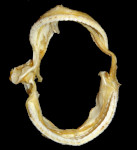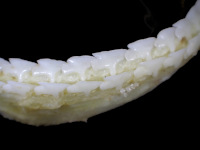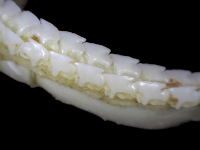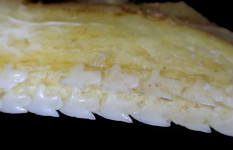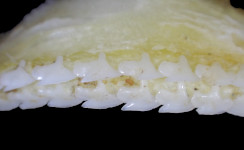Squalus hawaiiensis
Daly-Engel, Koch, Anderson, Cotton & Grubbs, 2018
Classification: Elasmobranchii Squaliformes Squalidae
Reference of the original description
Description of a new deep-water dogfish shark from Hawaii, with comments on the Squalus mitsukurii species complex in the West Pacific. ZooKeys, 798, 135–157
Description of a new deep-water dogfish shark from Hawaii, with comments on the Squalus mitsukurii species complex in the West Pacific. ZooKeys, 798, 135–157
Types
Squalus hawaiiensis
Holotype: UF: 241161 (Sha116); Paratype: UF: 241162 (Sha114); UF: 241163 (Sha117);
Squalus hawaiiensis
Holotype: UF: 241161 (Sha116); Paratype: UF: 241162 (Sha114); UF: 241163 (Sha117);
Description :
Citation: Squalus hawaiiensis Daly-Engel, Koch, Anderson, Cotton & Grubbs, 2018: In: Database of modern sharks, rays and chimaeras, www.shark-references.com, World Wide Web electronic publication, Version 12/2025
Please send your images of "Squalus hawaiiensis" to info@shark-references.com

Squalus hawaiiensis Daly-Engel, Koch, Anderson, Cotton & Grubbs, 2018, UF241161, female 750.5 mm TL, Kaneohe Bay, Oahu, Hawaii © Daly-Engel, Koch, Anderson, Cotton & Grubbs, 2018

Squalus hawaiiensis Daly-Engel, Koch, Anderson, Cotton & Grubbs, 2018, UF241161, female 750.5 mm TL, Kaneohe Bay, Oahu, Hawaii © Daly-Engel, Koch, Anderson, Cotton & Grubbs, 2018
Common names
 Hawaiian Spurdog
Hawaiian Spurdog
 Hawaiian Spurdog
Hawaiian Spurdog
Short Description
Original Diagnosis of DALY-ENGEL, KOCH, ANDERSON, COTTON & GRUBBS, 2018 [26776]: A large species of Squalus of the ‘mitsukurii group’ with the following combination of characters: body relatively slender, trunk height 8.7–12.4% TL (mean 10.1% TL, n=8; Figure 3); snout is angular and short to moderate in length, mouth width 1.35–1.60 (1.48) times horizontal prenarial length and pre-oral length is 1.92– 2.06 (1.97) times the prenarial length (Figure 4); pre-first dorsal length 30.3–31.5 (30.2)% TL; pre-second dorsal length 63.6–67.0 (65.5)% TL; interdorsal space 26.7– 30.0 (28.6)% TL; pelvic-caudal space 25.2–29.3 (27.1)% TL; relatively small, up¬right dorsal fins; first dorsal fin length 11.4–12.8 (12.2)% TL, height 6.5–7.8 (7.3)% TL, inner margin length 4.9–5.7 (5.4)%% TL; second dorsal fin length 10.6–11.7 (11.1)% TL, height 4.0–4.6 (4.4)% TL, inner margin length 4.3–4.9 (4.6)% TL; first dorsal fin spine length 46.6–64.6 (55.6)% of first dorsal fin height; second dorsal spine length 104.5–114.5 (109.0)% of second dorsal fin height; caudal bar triangular, extending from the caudal fork nearly to the anterior edge of the lower caudal, distinct upper caudal blotch and fringe in juveniles, upper caudal blotch diffuse in adults but extending to the posterior margin of the upper caudal fin, upper and lower caudal fins white tipped; flank denticles tricuspid (Figure 5A–C); teeth are similar in appearance in the upper and lower jaw, with numbers ranging from 26–28 in the upper jaw and 23 in the lower jaw; 41–45 monospondylous centra, 85–89 precaudal centra, 112–116 total centra; adult maximum size at least 101 cm TL.
Original Diagnosis of DALY-ENGEL, KOCH, ANDERSON, COTTON & GRUBBS, 2018 [26776]: A large species of Squalus of the ‘mitsukurii group’ with the following combination of characters: body relatively slender, trunk height 8.7–12.4% TL (mean 10.1% TL, n=8; Figure 3); snout is angular and short to moderate in length, mouth width 1.35–1.60 (1.48) times horizontal prenarial length and pre-oral length is 1.92– 2.06 (1.97) times the prenarial length (Figure 4); pre-first dorsal length 30.3–31.5 (30.2)% TL; pre-second dorsal length 63.6–67.0 (65.5)% TL; interdorsal space 26.7– 30.0 (28.6)% TL; pelvic-caudal space 25.2–29.3 (27.1)% TL; relatively small, up¬right dorsal fins; first dorsal fin length 11.4–12.8 (12.2)% TL, height 6.5–7.8 (7.3)% TL, inner margin length 4.9–5.7 (5.4)%% TL; second dorsal fin length 10.6–11.7 (11.1)% TL, height 4.0–4.6 (4.4)% TL, inner margin length 4.3–4.9 (4.6)% TL; first dorsal fin spine length 46.6–64.6 (55.6)% of first dorsal fin height; second dorsal spine length 104.5–114.5 (109.0)% of second dorsal fin height; caudal bar triangular, extending from the caudal fork nearly to the anterior edge of the lower caudal, distinct upper caudal blotch and fringe in juveniles, upper caudal blotch diffuse in adults but extending to the posterior margin of the upper caudal fin, upper and lower caudal fins white tipped; flank denticles tricuspid (Figure 5A–C); teeth are similar in appearance in the upper and lower jaw, with numbers ranging from 26–28 in the upper jaw and 23 in the lower jaw; 41–45 monospondylous centra, 85–89 precaudal centra, 112–116 total centra; adult maximum size at least 101 cm TL.
Size / Weight / Age
TL (max) females: 101 cm, males: 78 cm; TL (mature): female: ~64 cm, male ~47 cm TL. [26776]
TL (max) females: 101 cm, males: 78 cm; TL (mature): female: ~64 cm, male ~47 cm TL. [26776]
Dentition
teeth are similar in appearance in the upper and lower jaw, with numbers ranging from 26–28 in the upper jaw and 23 in the lower jaw [26776]
teeth are similar in appearance in the upper and lower jaw, with numbers ranging from 26–28 in the upper jaw and 23 in the lower jaw [26776]
Remarks
shark-references Species-ID=15244
shark-references Species-ID=15244









